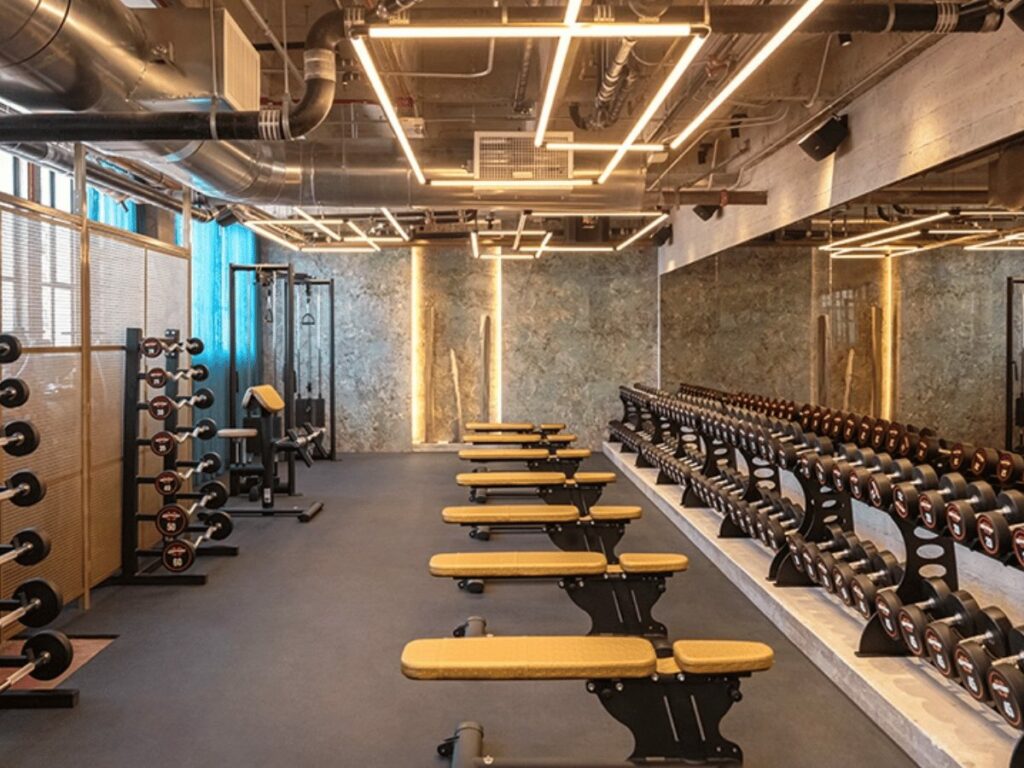Dreaming of gym ownership? In an era when the fitness industry is thriving and generating over $100 billion worldwide, it’s no surprise that entrepreneurs want to seize a piece of this lucrative market. However, the path to purchasing a gym business can be littered with complexities and decisions that require careful consideration
The good news is opting for an established gym can expedite the return on investment, reduce startup time, and offer an existing customer base to build upon. This guide demystifies the buying process, breaking it down into comprehensive steps that aid informed decision-making. When considering what type of business to establish as a gym owner, it’s essential to weigh the advantages and disadvantages of being a gym owner.
Fasten the seatbelts and read on!
Table of Contents
1. Understanding the Gym Industry
The gym industry, laden with opportunities, has been on an upward trajectory for several years. With a society that is increasingly conscious about health and wellness, gyms have become an essential service for many. In addition, the advent of technology has enabled gym owners to provide more sophisticated and diverse services, ranging from virtual classes to mobile apps that track progress.
Yet, I assume the industry is also highly competitive. Many enterprising individuals have recognized the lucrative nature of the fitness market, which has led to a saturation of gyms and fitness centers. This demands aspiring gym owners to have a deep understanding of the industry landscape and tailor their services to carve a niche.
2. Evaluating Your Interest and Capability
Before diving into the gym business, it’s crucial to conduct a personal assessment to gauge your interest and capability in this industry. Here are some to explore:
Assessing Passion for Fitness
For someone contemplating buying a gym business, it’s crucial to have an inherent passion for fitness. This passion serves as a driving force, propelling one to keep abreast of new fitness trends and better cater to clients’ needs. A genuine interest ensures that the business doesn’t feel like a chore, but rather a fulfilling endeavor. Understanding the potential challenges, including What are the disadvantages of being a gym owner?, is also vital to make informed decisions and mitigate risks in the fitness industry.

Evaluating Management Skills
Running a gym is not just about fitness; it’s also about effective management. This includes managing staff, maintaining equipment, and ensuring that the gym adheres to health and safety standards. I hold on to this, it’s important to have a solid understanding of basic management principles or be willing to learn them.

Gauging Market Trends
An astute gym owner stays informed about the latest market trends. From emerging workout regimes to health fads, staying current is crucial for the business. In my experience, with knowledge of market trends, one can effectively modify gym offerings, ensuring they are always in demand.

Financial Capacity and Support
Understanding personal financial capacity is indispensable. One should evaluate their financial resources and how much they are willing to invest in a gym business. Moreover, exploring financing options or partners like Yanre Fitness, which could provide essential support in setting up the business, can be extremely helpful.
3. Type of Gym Business to Buy
There are various types of gym businesses available, and selecting the right fit is vital for long-term success. Let’s dive into the different types of gym businesses.
Traditional Fitness Centers
Traditional fitness centers offer the most common form of gym business. They provide general fitness equipment such as treadmills, weights, and sometimes group classes. For those looking to serve a broad audience, this type of gym is a safe bet. However, it’s essential to thoroughly research and understand your target market and What is the best type of business for a gym? to determine the most suitable gym business model for your goals and local demographics.
Advantages:
- Broad Market Appeal: Traditional fitness centers appeal to a wide range of customers, as they offer a variety of general fitness equipment and classes that cater to different fitness goals.
- Consistent Demand: There is a steady demand for traditional fitness facilities due to their established presence and the perpetual need for fitness services among the general population.
- Diverse Revenue Streams: Traditional fitness centers can generate revenue from multiple sources, including membership fees, personal training, group classes, and the sale of fitness merchandise.
Specialized Studios
Specialized studios focus on specific types of fitness such as yoga, Pilates, or spinning. These studios generally attract a more niche audience. In my point of view, for businesses that have a deep passion for a specific type of fitness, this could be an ideal choice.
Advantages:
- Focused Target Market: Specialized studios, by catering to a specific niche, are able to tailor their services and marketing efforts more efficiently, resulting in a highly engaged and loyal clientele.
- Expert Positioning: By specializing in a particular type of fitness, these studios can establish themselves as experts in their field, leading to a strong brand reputation and customer trust.
- Customized Pricing: Specialized studios have the flexibility to charge premium prices for their specialized services, which can result in higher profit margins compared to general fitness centers.
Wellness Centers
I have seen wellness centers take a more holistic approach, combining physical fitness with other services like massage therapy or nutrition counseling. They cater to individuals who are looking to improve their overall health and well-being.
Advantages:
- Comprehensive Service Offering: Wellness centers offer an array of services, ranging from fitness training to nutrition counseling, which can attract individuals looking for a one-stop solution for their health and wellness needs.
- Growing Market: With the increasing awareness of holistic well-being, the market for wellness centers is expanding, creating ample opportunities for growth and diversification.
- Positive Social Impact: Wellness centers can make a significant positive impact on the community by promoting a healthier lifestyle and potentially improving the overall well-being of their patrons.
24-hour Gyms
These gyms are appealing for their accessibility. They cater to people with varying schedules who appreciate the flexibility of working out at any time. This model generally requires less staff, as some hours operate with minimal supervision.
Advantages:
- Accessibility and Convenience: 24-hour gyms provide unmatched accessibility, catering to individuals with irregular schedules and those who prefer to work out during off-peak hours.
- Lower Operational Costs: With minimal staffing requirements during certain hours, 24-hour gyms can operate at a lower cost compared to traditional fitness centers.
- Competitive Edge: The round-the-clock availability of 24-hour gyms offers a competitive advantage over conventional gyms, making them more attractive to potential members.
Franchise Gyms
Buying into a franchise can be a less daunting prospect than starting from scratch. With a franchise, one gets a ready-made brand, support, and an established business model.
Advantages:
- Established Brand and Support: Franchise gyms come with an established brand, proven business models, and support systems, reducing the risks associated with starting a business from scratch.
- Marketing and Operational Efficiency: Franchisees benefit from national marketing campaigns and operational efficiencies that come from being part of a larger network.
- Expansion Opportunities: Being part of a franchise network offers opportunities for multi-unit ownership, allowing for the expansion of the business into different markets.
4. 5 Key Considerations When Buying a Gym Business
In 2023, total revenue from the fitness industry is projected to come in at 204 billion, with revenue expected to rise to 218.09 billion by 2023, 233.02 billion in 2025, and 248.99 billion in 2026, respectively. Purchasing a gym business requires a meticulous evaluation of multiple factors. See below the ff:

#1 Location and Demographics
The location of the gym is crucial. It’s vital to ensure that the gym is located in an area that is not only accessible but also has the right demographic. Researching the local community and their fitness preferences can inform the decision. On a personal note, the joy of seeing locals embrace a healthier lifestyle because the gym fits seamlessly into their community is immeasurable.
#2 Existing Clientele
When buying an existing gym business, it’s important to consider the current clientele. Understanding their needs and preferences is critical in ensuring a seamless transition and maintaining customer retention. Engage with the members – they are not just a revenue stream, but also the lifeblood that keeps the energy of the place going.
#3 Condition of Equipment and Facilities
An evaluation of the existing equipment and facilities is necessary. Ensuring that the equipment is in good condition or budgeting for replacements and upgrades can save a lot of unexpected expenses down the line. Let’s face it; nobody wants to work out with equipment that looks like it belongs in a museum.

#4 Legal and Compliance Aspects
A thorough check of all the legal aspects, including the lease, licenses, and compliance with health and safety standards, is essential. For example, engaging a lawyer with experience in the fitness industry is really advisable.
#5 Financial Evaluation
Examining the financial health of the business is a must. This includes reviewing profit and loss statements, balance sheets, and membership revenues. Additionally, one should also project future earnings based on market trends and planned improvements.
5. The Buying Process
An effective buying process minimizes risks and sets the foundation for a prosperous venture. Let’s discuss the 5 steps below:
Step#1 Research and Shortlisting
Initially, potential buyers need to conduct thorough research on available gym businesses for sale. Shortlisting options based on preferences, budget, and market research is the first step in the buying process. Personally, I believe the satisfaction of ticking off all the boxes on a dream gym checklist is priceless.
Step#2 Initial Contact and Inquiry
After shortlisting, it’s time to contact the sellers or brokers to inquire about more details. This is the stage to ask questions regarding equipment, clientele, financials, and any other relevant information. Don’t be afraid to ask the hard questions – and keep an ear out for what they’re not saying as much as for what they are.
Step#3 Site Visits
Before making any decisions, it’s crucial to visit the site. This allows for a firsthand evaluation of the facilities, equipment, and general ambiance of the gym. It also provides an opportunity to interact with staff and clients. Walking into a gym and absorbing the energy is like a sip of a perfect cup of coffee in the morning; if it feels right, it might just be the one. Be observant and talk to people.
Step#4 Negotiation and Offer
Once satisfied with a particular gym, negotiation starts. This stage involves discussing the price, terms of payment, and any conditions that might be part of the sale. Following negotiations, an official offer is made. Remember, it’s not just buying a business; it’s stepping into someone’s dream. Honor that, and find that sweet spot where the deal feels like a win-win.
Step#5 Closing the Deal
The final stage is closing the deal. This involves signing contracts, transferring funds, and officially taking over the gym. It’s advisable to have legal representation to ensure that all documentation is in order. This is the beginning of an adventure that can transform not just the business life but the lives of many others.
6. Potential Challenges and Solutions
I can tell operating a gym business comes with its set of challenges. Adopting inclusive leadership, characterized by awareness of biases, humility, and empathy, can enhance performance by adapting to diverse markets and customer needs.
Challenges:
- Membership Retention
One of the biggest challenges is retaining members. People tend to join gyms with enthusiasm but often lose interest or find alternatives. For example, during the pandemic, many people turned to alternative fitness options such as biking, joining walking clubs, or using interactive fitness devices like Peloton and Mirror.
- Competition
With the abundance of fitness centers, competition is fierce. Standing out amongst a plethora of options can be daunting. Some boutique fitness studios focusing on specific types of workouts like spinning or yoga have surged in popularity, forcing traditional gyms to rethink their offerings.
- Keeping Up with Trends
The fitness industry is ever-evolving. Keeping up with trends and continuously updating services to meet customer demand is a constant challenge. For instance, I saw gyms and fitness centers had to quickly adapt to virtual and hybrid models during the COVID-19 pandemic to stay relevant and keep their members engaged.
- High Operating Costs
Gym businesses are increasingly adapting to the evolving fitness industry by integrating technology and offering hybrid fitness services. When opening a gym, entrepreneurs often face high operating costs including rent, equipment maintenance, and staff salaries.
Solutions:
- Engaging and Diverse Programs
Personally, offering engaging and diverse programs keeps members interested. Incorporate classes, challenges, or events to foster a community atmosphere. Implementing fitness challenges such as weight loss competitions or goal-specific training programs is good.
- Unique Selling Proposition
Identifying a Unique Selling Proposition (USP) and effectively communicating it can set the gym apart from competitors. This could be specialized classes, exceptional customer service, or state-of-the-art equipment. Some gyms offer niche classes like aerial yoga or aqua cycling to differentiate themselves from competitors.
- Continuous Market Research
Believe it, staying informed about industry trends through continuous market research is key. Additionally, seeking feedback from members can provide insights into desired services. Offering online classes and digital fitness content can be essential for keeping members engaged.
- Efficient Management and Strategic Partnerships
Implementing efficient management practices to reduce wastage and optimize resources is important. Moreover, forging strategic partnerships with businesses like Yanre Fitness can help in the cost-effective sourcing of equipment and services.
The table outlines potential challenges faced when buying a gym business, such as membership retention and high operating costs, along with corresponding solutions, including engaging programs and efficient management practices.
| Challenges | Solutions |
| Membership Retention | 1. Offer engaging and diverse programs like classes, challenges, and events to foster a community atmosphere. 2. Implement fitness challenges and goal-specific training programs. |
| Competition | 1. Identify a Unique Selling Proposition (USP) and effectively communicate it to differentiate from competitors. 2. Offer specialized classes, exceptional customer service, or state-of-the-art equipment. |
| Keeping Up with Trends | 1. Stay informed about industry trends through continuous market research. 2. Seek feedback from members to understand and adapt to their desired services. 3. Offer online classes and digital fitness content to keep members engaged. |
| High Operating Costs | 1. Implement efficient management practices to reduce wastage and optimize resources. 2. Forge strategic partnerships with businesses for cost-effective sourcing of equipment and services (e.g., Yanre Fitness). |
7. Conclusion
As we delve into this ultimate guide to buying a gym business, it’s clear that navigating the processes involves significant attention to detail, a sound business plan, and an understanding of the fitness industry. Finding a gym business model for future growth that align with the objectives and ambitions of the enterprise is essential.
We encourage all businesses looking to make such a strategic move to thoroughly evaluate their preparedness and market feasibility. Our team of experts is readily available to assist with any queries regarding gym business acquisition. Contact us today, ensure no question goes unanswered, and enable a well-informed decision-making process. The road to successful gym ownership, including what do you need to open a gym, awaits.
Related articles:








